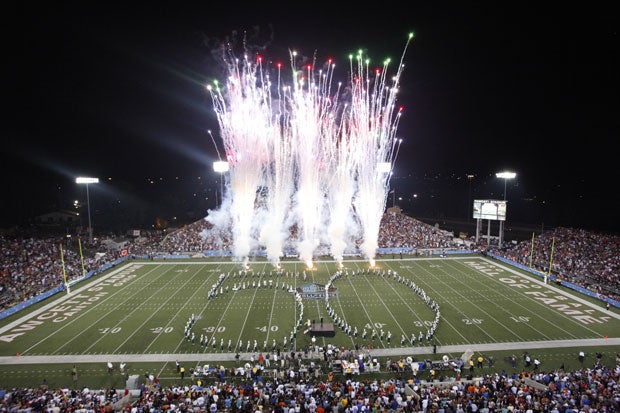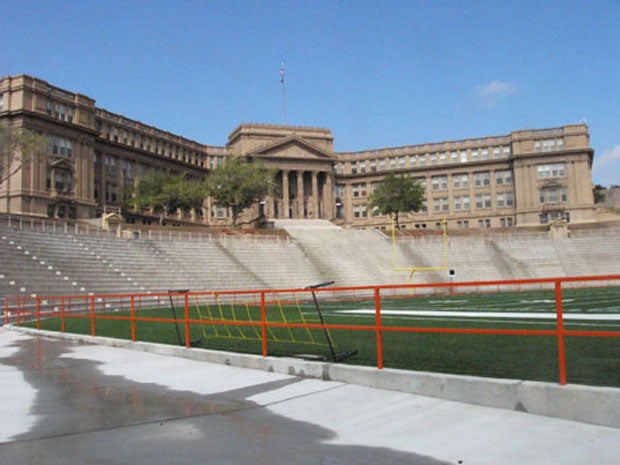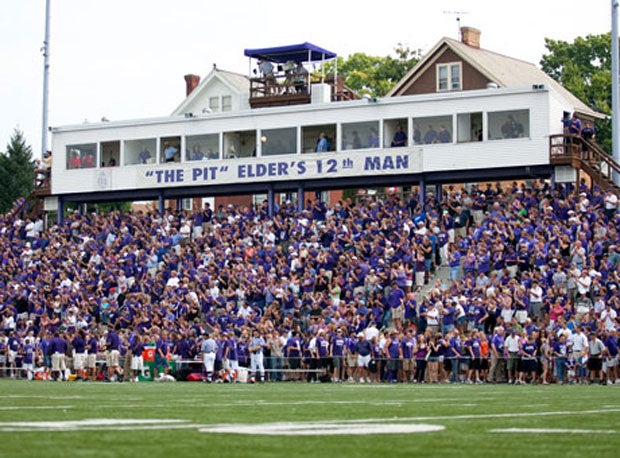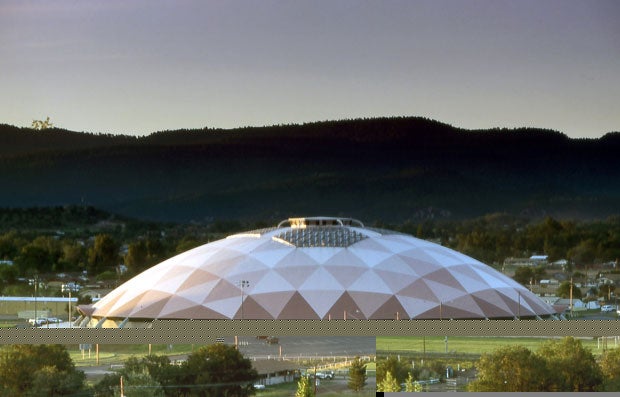A $59.6 million jewel, a view of the Golden Gate Bridge and the home of "Friday Night Lights" are three of the 10.
*Editor's note: This story originally ran Aug. 7, 2012 and has been re-dated for July 27, 2014. No content was changed.High school football is a spectacular spectacle, regardless of where the contest is played.
But 10 particular places stand out in our minds, some because of the fan experience, some because of the history and some because of the natural scenery that provides a background to the athletic contest.
Come along and see our slideshow of 10 high school football stadiums to see before you die. Life is short, so if you get the chance to trek to one of these fields, take it!
Allen Eagle Stadium: Allen, Texas
Allen (Texas) will open the nation's newest - and probably most expensive - high school football stadium in the country on Aug. 31 when it plays host to perennial powerhouse Carroll (Southlake, Texas) in a classic that is expected to overflow its 18,000-seating capacity.
View slideshow of Allen Eagle StadiumEverything seems to be bigger than life in Texas, so it's not too surprising that taxpayers did not put up a major fuss over the $59.6 million price tag. That's probably because Collin County residents have the highest medium income in the state and Collin County is one of the 25 wealthiest in the country.
Approximately 7,500 reserved, chair-back seats will be sold on a season basis each year. Officials also are reserving 5,000 seats for fans of the visiting team, 4,000 for Allen students and 1,000 for the school's band. That leaves a mere 500 for general admission each week.
Though it will be only the fifth-largest stadium in Texas, it will be the largest used by only one high school.
The stadium also includes locker rooms for the golf team and facilities to hold wrestling meets.
{PAGEBREAK}
Fawcett Stadium: Canton, Ohio

Photo courtesy of Pro Football Hall of Fame
Fawcett officially was dedicated in 1938, seating 15,000, and was the largest high school football stadium in the country at the time. It was built by the Works Progress Administration at a cost of $500,000. It seats 22,400 today.
It's literally a Hall of Fame stadium: It is located next to the Pro Football Hall of Fame and since 1962 has been the site of the annual preseason Hall of Fame Game that pits NFL teams against each other. When $4.3 million in improvements were made in 1997, it was renamed to include the words Pro Football Hall of Fame Field.
Those improvements included state-of-the-art field turf, new locker rooms, a new scoreboard with graphics display screen, new lighting, new sound system, new electrical services, structural repairs, vinyl caps for all wooden seats and a renovated press box.
Five years later the Sporting News named Fawcett Stadium the No. 1 high school football venue in the country.
Presently it is the home field for
McKinley (Canton, Ohio) and
Timken (Canton, Ohio), as well as Walsh University and Malone University. Several other prep teams also have used it as a home field over the years. Three state championship games also are played there every year as well.
{PAGEBREAK}
Jones Stadium: El Paso, Texas

Photo courtesy of Matt Stepp/ TheOldCoach.com
Jones was the first major concrete stadium built in the country, opening in 1916 with a seating capacity of 12,000. The stadium is the home field for
El Paso (Texas) and the entire package was constructed at a cost of $500,000.
The school is nicknamed "The Lady on the Hill" because it sits on a mountainside at the foot of the Franklin Mountains. It overlooks central El Paso and its border with Ciudad Juarez, Mexico. The school actually wraps around the stadium and semicircular steps lead from the field directly to the main entrance of the school. Combined, they take up four city blocks.
Officials estimate that if this same package was put together today, it would cost more than 10 times its original price. El Paso High, which has beautiful marble floors, was named a historic landmark in 1980 by The National Register of Historic Places.
General John J. "Black Jack" Pershing once rode his horse into Jones Stadium to help celebrate the end of World War I and the first three Sun Bowl games also were held there.
Due to crumbling concrete, the stadium was rebuilt to original specifications in 1993.
Quick aerial flyover of Jones Stadium
{PAGEBREAK}
Monument Valley High: Utah

Photo courtesy of Evan Reader/ flickr.com/people/greatestpaka/
This field, located close to the Arizona border in the heart of the Navajo Reservation, provides a world-famous view of desert landscape. Watching from the stands as the sun begins to set, one can see ancient red-rock formations go from red to orange to purple to maroon at
Monument Valley (Utah).
The breathtaking beauty of this area has been recorded over and over again in countless movies: Easy Rider, Forrest Gump, Cars, Mission: Impossible II and many more.
The field forms one of the few patches of green in the area and is situated in a small bowl. The sky seems to stretch forever on the northern horizon.
Fry bread and beans are sold at the concession stand, a student sings the National Anthem in Navajo and fans are known to build a campfire nearby as the night air cools. Sometimes the PA announcer has to remind fans to keep their truck lights off as they park around the field.
And, once in awhile, several cows will wander across the field, briefly stopping play.
{PAGEBREAK}
The Pit: Cincinnati

File photo by Wayne Litmer
The Pit was started in the 1930s by student and parent volunteers, but due to World War II was not completed until 1947. It seats 10,000.
Located on the west side of Cincinnati at
Elder (Cincinnati), the Pit is horseshoe-shaped and was dug into Price Hill. The concrete stadium has the closeness of a basketball court with the sidelines resting a mere 5 yards from the stands. That creates a very intimate - and intimidating - atmosphere that greatly favors the home team.
Elder's rabid fan base could be compared to Chicago Cubs' fans at Wrigley Field because some have built decks on their homes to watch games from a distance.
Experience a day at Elder in this photo galleryIt's in the middle of a neighborhood, surrounded by trees. The field itself contains a Vietnam Veterans Memorial Wall, which contains the names of 11 Elder graduates who died in the war - the most in Ohio.
Game festivities include cookouts, raffles and once, a soldier brought in the game ball via helicopter.
{PAGEBREAK}
Ratliff Stadium: Odessa, Texas

Photo courtesy of Bob McSpadden/ Texasbob.com
Ratliff Stadium seats 19,302 and has been called the "Epicenter of Texas High School Football." Built in 1982 at a cost of $5.6 million, Ratliff is the home to
Odessa (Texas) and
Permian (Odessa, Texas).
Permian is a past national champion, and the program has been the subject of a book and the TV series "Friday Night Lights."
The stadium is totally wired for modern media exposure. All games are rebroadcast on public access channels in the Midland/Odessa market on Sunday afternoons, and sometimes playoff games are televised live.
All seats are reserved except for the student sections. The ticket booth has five windows, but the demand for tickets is so great that sometimes it never opens due to sellouts. It's not uncommon for fans to line up the night before to purchase tickets ahead for big games.
{PAGEBREAK}
Round Valley Ensphere: Eagar, Ariz.

Photo courtesy of SPS+ Architects, LLP
Situated at an elevation higher than 7,000 feet in eastern Arizona and completed in 1991, this was the first domed high school football stadium in the country. The facility, which cost $11 million, has 189,000 square feet.
Near the New Mexico border, the Ensphere is home to
Round Valley (Eagar, Ariz.) and can host a football game, tennis match and either a basketball or volleyball game at the same time. It is home for six different sports overall.
The Ensphere can get very loud, which is intimidating to opponents, but on the other side of the coin Round Valley players have to make somewhat of an adjustment when they play on outdoor fields.
President George W. Bush visited the Ensphere in 2002, but it was in reference to destructive wildfires in the area.
{PAGEBREAK}
Stadium Bowl: Tacoma, Wash.

Photo courtesy of Localism.com
Originally known as Tacoma Stadium, this unique field at
Stadium (Tacoma, Wash.) was considered an "eighth wonder of the world" when it was completed in 1910. It was built on the site of a luxury hotel that burned down in a mysterious fire before its completion.
It has a breathtaking view of the Puget Sound and was spotlighted in the movie "Ten Things I Hate About You."
Over the years, Stadium Bowl has been the gathering place for celebrities from all walks of life. In 1911, future President Theodore Roosevelt spoke there to a crowd of 40,000 and stated he had seen nothing like it anywhere else in the world. Musician John Phillip Sousa performed there in 1915 before a crowd of 25,000 and praised the superb acoustics. In 1919, President Woodrow Wilson spoke there before 40,000 on a whistle-stop tour.
Other big names to appear there include the likes of Babe Ruth, Jack Dempsey, Louie Armstrong, Bob Hope, Billy Sunday and William Jennings Bryan.
It originally seated 32,000, but erosion caused enough damage to reduce today's capacity to just 15,000.
In the video below, scenes depicting the Stadium Bowl are from about 3:30 to 4:50.
{PAGEBREAK}
George Washington High School: San Francisco

Photo courtesy of Tawnya Gray/ GrayStarSports.com
If you don’t hear giant roars or witness raucous fans at
Washington (San Francisco), it’s for good reason. They might just be gawking at the breathtaking views of the Golden Gate Bridge.
Tourists from throughout the world travel to gander at the golden structure, considered a national symbol and tabbed one of the Wonders of the World by the American Society of Civil Engineers. But the Eagles get to stare at it every day at practice.
Built in 1940 in San Francisco’s picturesque Richmond District, the stadium overlooks the Golden Gate, deemed by Frommers Travel Guide as “possibly the most beautiful, certainly the most photographed, bridge in the world.”
Called simply Washington High School Stadium, the field is also accented by a beautiful 2,500 square foot frieze with panels that depict both ancient and modern sports in the Olympics. Quotations from Plato and other philosophers are also displayed.
Three years ago, the field was updated with artificial turf, which helped attract the Miami Dolphins, who secretly practiced there in December of 2010 before a game with the Oakland Raiders. School wasn’t in session and no one other than the school’s principal and athletic director were alerted (They were sworn to secrecy). The 1968 Baltimore Colts, who lost to the Jets and Joe Namath in the Super Bowl, also practiced at the stadium.
{PAGEBREAK}
The Wolvarena: Pittsburgh

Photo courtesy of Lee Schaeffer/ schaeffersite.com/football
Home of
Woodland Hills (Pittsburgh), the Wolvarena also has been known as Turtle Creek Stadium. It was built in 1942 and seats 12,500. In recent years it has received an $8 million facelift, which included artificial turf, a paved parking lot, new bleachers and restrooms.
Due to a rabid fan base, the stadium once was voted "most intimidating stadium in Pennsylvania," in large part because the seats are less than 10 yards from the sidelines.
Among famous alumni who have played at the stadium is Leon Hart, who won the 1949 Heisman Trophy at the University of Notre Dame. He played for Turtle Creek, which now is part of the three-school Woodland Hills consolidation.
Available at the concession stand are such items as stuffed cabbage, kielbasa and sauerkraut.